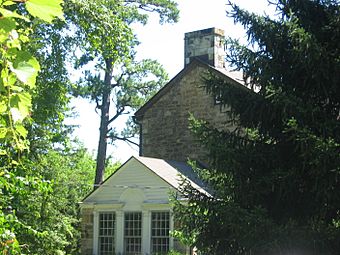Renick House facts for kids
Quick facts for kids |
|
|
Renick House, Paint Hill
|
|

Western end of the house
|
|
| Location | 17 Mead Dr., Chillicothe, Ohio |
|---|---|
| Area | 5 acres (2.0 ha) |
| Built | 1804 |
| Architect | Presley Morris |
| Architectural style | Virginia Style |
| NRHP reference No. | 73001528 |
| Added to NRHP | May 9, 1973 |
The Renick House, also known as "Paint Hill", is a very old and special house in Chillicothe, Ohio, United States. It was built a long time ago in 1804. This house is made of stone and has two floors. It is shaped like the letter "L" when you look at it from above.
The Renick House has some cool features. It has pointy roof parts called gables. There are also big chimneys on each end of the house. A huge chimney sits right in the middle too. The front door is in the center and has a special window above it called a fanlight. There's also a porch with a fancy triangle shape above it, known as a pediment. The outside walls are made of sandstone. They have six openings: three windows upstairs and the front door with two windows downstairs.
History of the Renick House
Who Built and Lived Here?
This house is built in a style called "Virginia-style Federal". This was a popular way to design buildings when the United States was still quite new. A person named Presley Morris was in charge of building it.
The very first person to live in the Renick House was George Renick. He was an important person in Chillicothe. George Renick helped with one of Ohio's first ever cattle drives. Imagine this: he led ninety-six cattle all the way from the Scioto River valley to Baltimore, Maryland! That was a huge journey back then.
Over the years, other people owned the house. At one point, a Presbyterian church bought it. They used it as a manse, which is a house where a church minister lives. In 1904, a part was added to the house. This new section, called an ell, made the house even bigger.
A Historic Landmark
In 1973, the Renick House was added to the National Register of Historic Places. This is a special list of buildings, sites, and objects that are important in American history. The house was chosen for this list for two main reasons. First, its old architecture was still in great shape. Second, it was connected to George Renick and his important role in early Ohio history.
There was also a smaller building nearby that was part of the property. It was considered important enough to be included with the main house on the historic list. This is called a contributing property.



